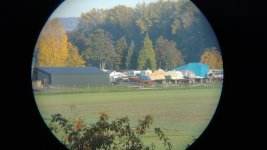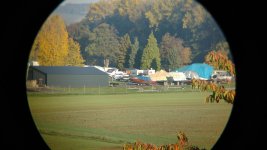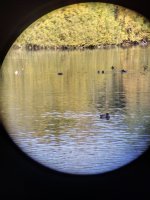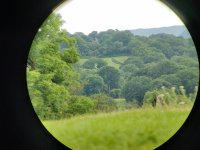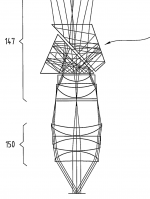tenex
reality-based
[Part I: Field of View is here]
We have today a dramatic contrast between conventional binocular optics, with typical amounts of field curvature and pincushion distortion, and a new approach dubbed Swarovision that appeared in 2010. Often referred to as "flat field", this design (and emulations of it since) actually involve two different factors that are often confused -- with the result that discussions of it tend to correct that confusion, and stop there. Instead I want to state this distinction at the outset, and then go on to ask further questions that don't seem to get addressed.
* Field curvature. Some eyepiece designs produce less of this than others, and a larger sweet spot. Modern ones may even include a specific "field flattener" element for the purpose, giving a broader area of acceptable sharpness. Swarovision took this a step further, offering usable sharpness to the very edge of the field. (Other aberrations also had to be well managed to achieve this.) Opinions vary as to how useful this really is in practice, but it's certainly a technical achievement and a marketing point.
* Distortion. Postwar binoculars typically employ noticeable pincushioning because the alternative (barrel or even zero rectilinear distortion) produces some angular compression (AMD) near the field edge, leading to squashed shapes and a "rolling ball/globe" effect (RB) that bothers some people when panning. (Of course pincushioning itself bends straight lines, so it's a trade-off. Minimal linear distortion was also common prewar.) Swarovision tilts the balance back toward neutral, but on closer inspection the distortion profile is no longer even uniform; it varies one way and then back again as it approaches the field edge.
With all this understood, further questions arise:
1. What is such complex distortion trying to accomplish? Is it an attempt to offer the best of both worlds, reducing the bending of straight lines near the edge while also minimizing the compression effect to keep panning comfortable? Why then does its profile vary among models, even of the same line? (Not to mention, how is any of this even possible? Surely some very complex aspheric surfaces are needed in the eyepiece.)
2. How did these two things come to be done together in Swarovision? Are they really separate innovations, or is the purpose of the distortion profile somehow related to having sharper field edges? (Does that make distortion effects worse? Did the calculations required for one make the other necessary as well?)
3. Why is this approach taking over the alpha binocular market when many don't need it, and some even dislike it? The RB effect has been reduced in more recent designs, but some are still sensitive to it. Some feel that sharpness throughout gives an unnaturally "flat" view, though it's not obvious why since any binocular offers a much narrower field than normal vision to begin with, and the eye itself has only a limited central area of sharpness that doesn't even cover that. Are they perceiving something subconsciously through peripheral vision? (I'm not drawn to such designs myself and would like to know why, since I don't share these objections and can't point to anything else specific that bothers me.)
I could say more, but possibly that's enough to get a discussion started...
We have today a dramatic contrast between conventional binocular optics, with typical amounts of field curvature and pincushion distortion, and a new approach dubbed Swarovision that appeared in 2010. Often referred to as "flat field", this design (and emulations of it since) actually involve two different factors that are often confused -- with the result that discussions of it tend to correct that confusion, and stop there. Instead I want to state this distinction at the outset, and then go on to ask further questions that don't seem to get addressed.
* Field curvature. Some eyepiece designs produce less of this than others, and a larger sweet spot. Modern ones may even include a specific "field flattener" element for the purpose, giving a broader area of acceptable sharpness. Swarovision took this a step further, offering usable sharpness to the very edge of the field. (Other aberrations also had to be well managed to achieve this.) Opinions vary as to how useful this really is in practice, but it's certainly a technical achievement and a marketing point.
* Distortion. Postwar binoculars typically employ noticeable pincushioning because the alternative (barrel or even zero rectilinear distortion) produces some angular compression (AMD) near the field edge, leading to squashed shapes and a "rolling ball/globe" effect (RB) that bothers some people when panning. (Of course pincushioning itself bends straight lines, so it's a trade-off. Minimal linear distortion was also common prewar.) Swarovision tilts the balance back toward neutral, but on closer inspection the distortion profile is no longer even uniform; it varies one way and then back again as it approaches the field edge.
With all this understood, further questions arise:
1. What is such complex distortion trying to accomplish? Is it an attempt to offer the best of both worlds, reducing the bending of straight lines near the edge while also minimizing the compression effect to keep panning comfortable? Why then does its profile vary among models, even of the same line? (Not to mention, how is any of this even possible? Surely some very complex aspheric surfaces are needed in the eyepiece.)
2. How did these two things come to be done together in Swarovision? Are they really separate innovations, or is the purpose of the distortion profile somehow related to having sharper field edges? (Does that make distortion effects worse? Did the calculations required for one make the other necessary as well?)
3. Why is this approach taking over the alpha binocular market when many don't need it, and some even dislike it? The RB effect has been reduced in more recent designs, but some are still sensitive to it. Some feel that sharpness throughout gives an unnaturally "flat" view, though it's not obvious why since any binocular offers a much narrower field than normal vision to begin with, and the eye itself has only a limited central area of sharpness that doesn't even cover that. Are they perceiving something subconsciously through peripheral vision? (I'm not drawn to such designs myself and would like to know why, since I don't share these objections and can't point to anything else specific that bothers me.)
I could say more, but possibly that's enough to get a discussion started...





